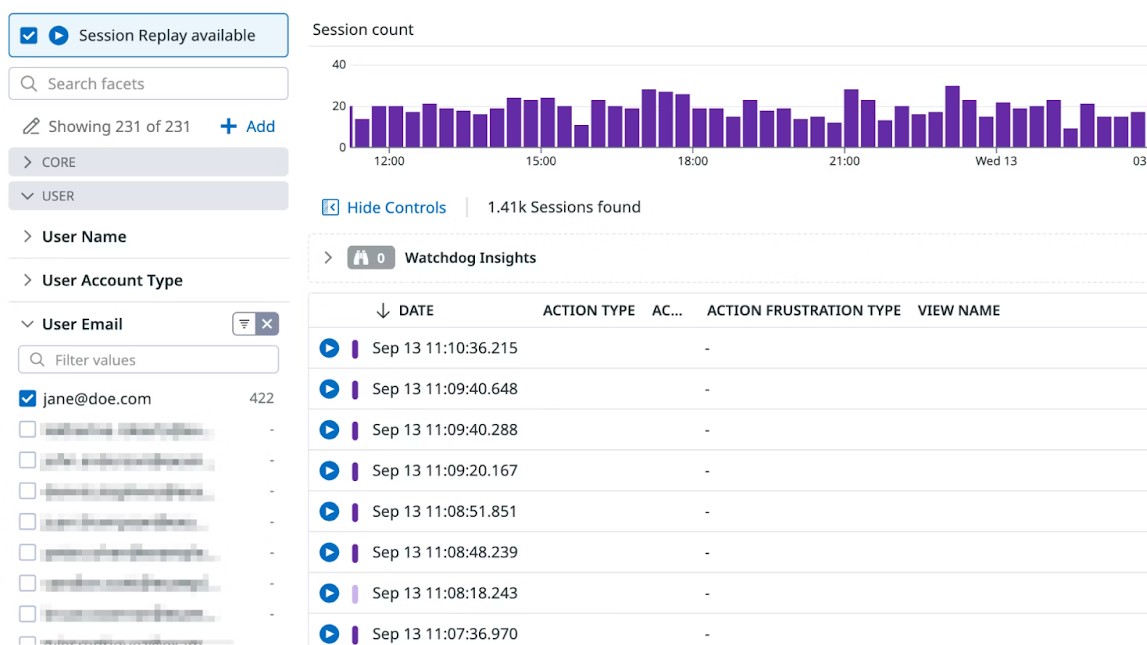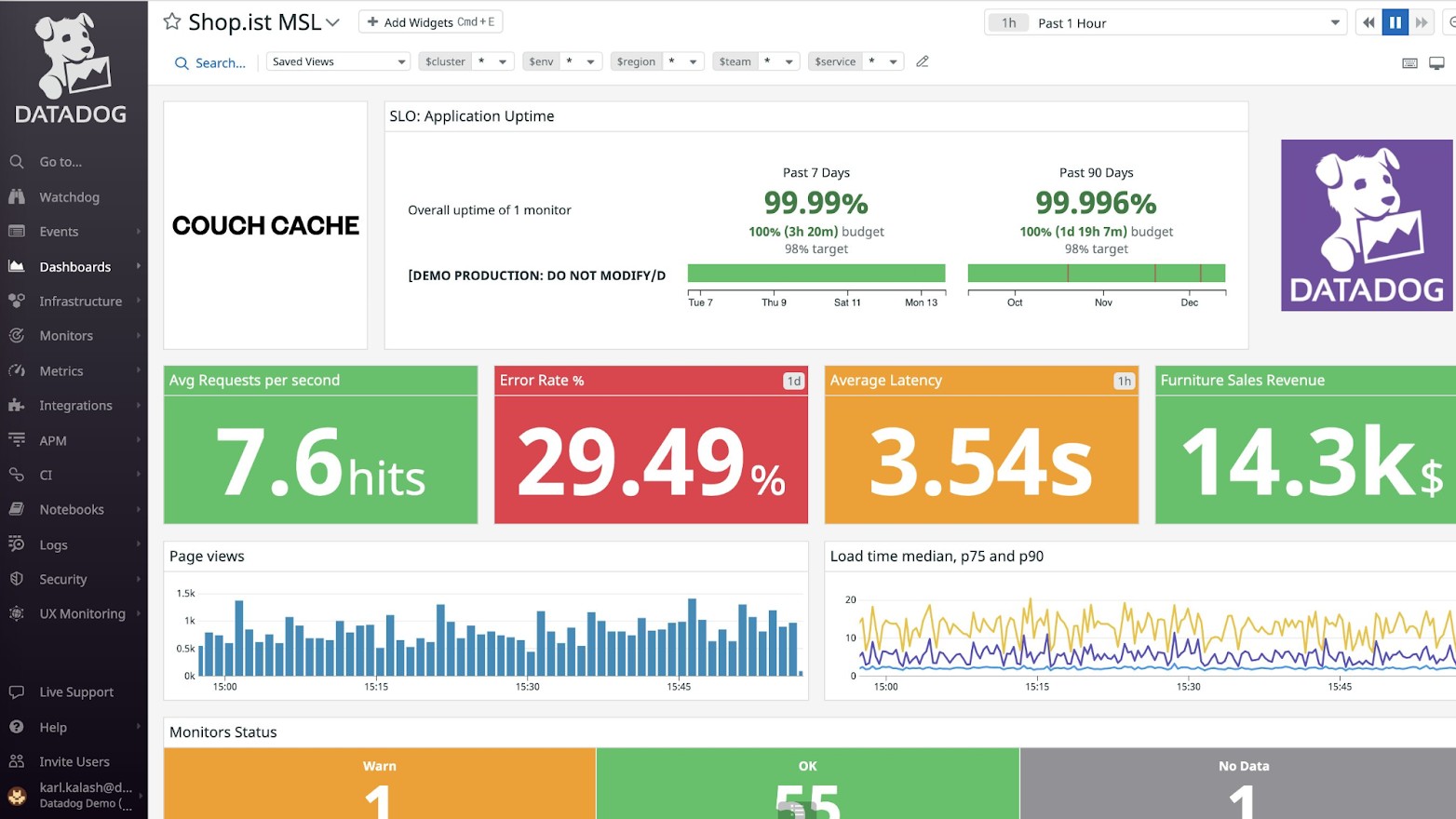Website monitoring is an essential part of the suite of business tools these days. After all, you cannot afford for your website to be down for even just a few minutes. Besides financial loss, it can hurt your brand’s reputation and market image.
Datadog offers top-notch website monitoring software that comes included with Real Time Monitoring (RUM), which is monitoring based on real user interactions. You also get robust synthetic monitoring, which allows you to test every component of your website. Business giants like Netflix, Adobe, Airbnb, and Spotify trust Datadog to manage their infrastructure.
If you want to know more about this all-around website monitor, stick around until the end. In this article, we’ll discuss Datadog's features, pricing, and interface, and also give you a couple of alternatives to consider.
Datadog: Plans and pricing
Datadog has separate plans for synthetic monitoring and real user monitoring, much like Pingdom. However, Datadog goes a step ahead and breaks these plans down further – it offers dedicated plans for API testing, browser testing, and mobile app tests.
The API testing plan costs $5/month for 10K test runs. The Browser Testing plan costs $12/month per 1,000 test runs, and the Mobile App Testing plan costs $50/month per 100 test runs.
There are two plans for RUM too, one with session replay and one without it. The RUM with Session Replay plan costs $1.80/month for 1,000 sessions, while the RUM plan (without replay) costs $1.50/month for 1,000 sessions.
These limits are enough for any small to midsized business, making Datadog an affordable solution. Except for the mobile app testing plan, you’ll only have to pay $18.80/month for RUM and synthetic monitoring. This is cheaper than the likes of Uptime.com, whose plans can cost as high as $67 to $285 per month.
Apart from website monitoring solutions, Datadog also offers a complete security suite with solutions like cloud and application security management, runtime code analysis, CI pipeline visibility, and network monitoring – each function has a separate plan.
Datadog: Features
Datadog’s Real User Monitoring is one of the best across the board. It churns out essential website performance data such as Core Web Vitals and load times by harnessing data from real user experiences.
The best thing about Datadog is that you can view session replays to pinpoint the exact cause and instance of the issue. This lets you collect and process every error, resource, and action during each session. Users' actions can vary from checkout button clicks, taps, and more. You can even track custom metrics that are critical to your performance.

Datadog also offers comprehensive Mobile Real User Monitoring (Mobile RUM) functions that test your app's stability, identify and address app crashes, and assist in resolving any glitches.
Its no-code web recorder makes it pretty easy to build customizable assertions that work on all the latest devices and operating systems. Datadog is also smart enough to avoid any UI changes so that you do not get any false positives.
Datadog’s API tests are ridiculously easy to create. You can access its API Catalog to access your overall HTTP test coverage and then build API checks for any untested endpoints in just a few clicks. Datadog’s AI-generated Synthetics swiftly identify any business-critical flows so that you can create the right test in a matter of seconds.
However, Datadog doesn’t stop at just detecting errors; it also helps in quick resolution by grouping related errors automatically so that you’re not bombarded with error notifications. You can run a simple faceted search to find out more about how these errors started and evolved.
Datadog also has one of the most extensive collections of third-party integrations, allowing you to set up custom workflows with as many as 800+ applications. Apps for various categories such as alerting, automation, caching, incident management, and log collection are available.
Datadog: Interface and in use
Datadog’s dashboards are filled with interactive charts and graphs that give you a quick snapshot of all running website checks. This graphic-oriented approach makes it easy for administrators to spot and resolve any errors.
Adding a new monitor is pretty straightforward. You simply need to select the request type, name it, add the URL, select locations you want to track from, and define alerting conditions.

When you create a synthetics test, Datadog collects data and generates dashboards about your stack, browser applications, overall test performance, private locations, and events. There are similar dashboards for API checks and browser checks, too.
If you’re running RUM, you’ll see a performance summary tab with immediate summaries of each app's vitals, error deployments, and user analytics.
However, given the number of functions and dashboards Datadog offers, you’ll need a bit of time to get the hang of the platform. There are tons of videos on the platform that guide you through the setup and day-to-day use of the platform.
Datadog: Support
Datadog offers decent support with all its paid plans. Chat support is available from 10 am EST to 7 pm EST on weekdays, while email support is available during business hours (8:00 PM Sunday - 9:00 PM Friday EST, excluding holidays). You can expect a reply within 2 hours for business-critical issues and 48 hours for general issues.
While this is good enough customer support, Datadog does offer something better. If yours is a large organization that needs 24/7 technical support, you can purchase Datadog's Premier support plan, which costs 8% of monthly spend ($2,000 minimum). However, you need to make a minimum of a one-year commitment for this plan.
Under this, you get 24/7 email, chat, and phone support, with response times as low as 30 minutes. Besides this, there’s a designated team of global support engineers as well as priority handling for escalations. Simply put, this will be just like having an in-house IT team dedicated to Datadog issues.
Datadog: The competition
Pingdom is a robust monitoring solution offering as many as 44 plans across synthetic and real user monitoring with different check thresholds. This makes it as ideal for small businesses that need to run just 10 uptime tests in a month as it is for large businesses that want to run, say, 30,000+ checks.
Much like Datadog, Pingdom also offers customizable graphical dashboards. Its top-level dashboards provide a quick summary of all website performance and page-level metrics to help drill this information deeper.
If you’re looking for something more affordable and value-packed, Host-Tracker can be a good option. Its plans start from just $9.9/month, allowing 10 website checks. You can add additional websites at just $0.70/site. In addition to synthetic monitoring, Host-Tracker also checks the IP DNS blacklist and Google’s unsafe websites list to ensure your websites aren’t blacklisted. However, it doesn’t offer RUM.
Datadog: Final verdict
Datadog is a one-stop solution for all your website monitoring and security needs. You get both real user monitoring and synthetic monitoring, like API tests, browser tests, and mobile app testing.
Each function is offered as a separate plan so that you have to pay only for the features you use. This is ideal for small businesses with limited needs. Datadog’s extensive information-driven dashboards make it a very intuitive platform. These dashboards are fully customizable, allowing you to drill data down as per your needs.
Plus, Datadog is one of the few monitoring solutions that offer a dedicated plan for premium support, with 24/7 call, email, and chat support. That said, such extensive features also come with a bit of a learning curve. However, there are a lot of resources and videos on the platform to help beginners out.
FAQs
Who is Datadog best for?
Datadog is an all-around business solution offering services like security monitoring, network monitoring, log management, and synthetic and real user monitoring. It's ideal for businesses of all sizes since it offers feature-specific plans. For instance, if you only need real user monitoring, you can get started for as low as $1.80/month.
Large businesses can also benefit from customized plans and a dedicated customer support plan that offers 247 chat, phone, and email support – something you won’t get with any other website monitoring solution.
What is website monitoring?
Website monitoring is the process of constantly checking your websites to ensure they're up and running. This is performed by specially designed tools, or website monitoring solutions, that alert you in case there are any unexpected downtimes. These tools also help businesses get insights into how users interact with their websites and improve components that have been slowing down user experience and load speeds.
We've also listed the best website defacement monitoring service.









 English (US) ·
English (US) ·